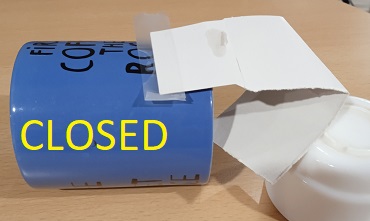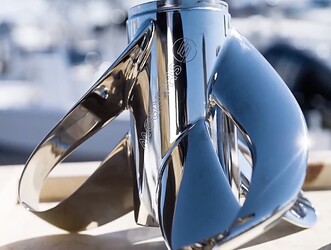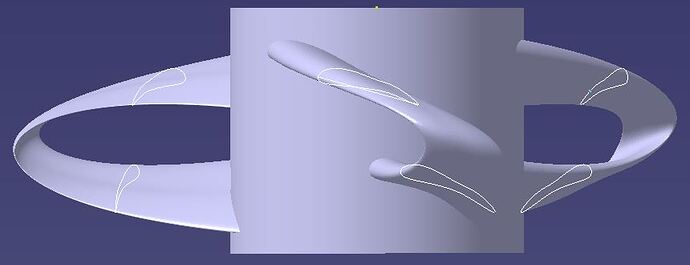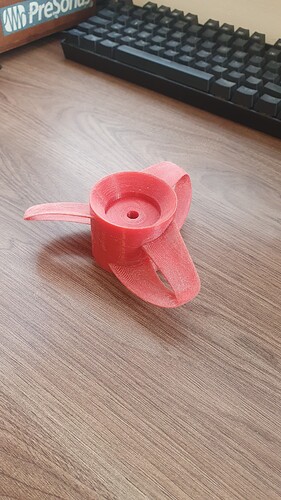Can’t post files here, one of the online places.
Unfortunately, I’m afraid we don’t have much choice but trial and error. That’s what the drone builders are doing with the toroidal prop. I think that starting from the FR prop scaling down the prop surface by 40 to 50% in chord and replicating the blade could be a good start.
On the toroidal prop side, here is an impressive 5 min design (Feb. 05 2023):
… but there is an obvious data problem at the moment (Feb 08 2023):
Hi, do you think it could be possible to design a retractable toroidal propeller?
Especially for e-foils whose propulsion is stopped once they reach the open sea.
We’re working on a project with my engeneering school
Yes, seems like it.
Looking at the sharrow prop it seems to breach some of the common propeller design rules. First blade has higher pitch than second?
Uploaded STL here: https://grabcad.com/library/65161-65162-loop-propeller-dia-138mm-1
Step file seems to take forever to convert. might crash so it’ll have to come later.
It’s 138mm outer diameter, for 65161/65162 threaded shaft motors with 4mm prop pin.
I didn’t try it so don’t ask me how good it is ![]()
The prop was adapted from the 200mm thinginverse prop linked earlier in this thread
I tried to measure pitch, i get it to be 3.2" and p/d ratio is 0.6. You normally find the best efficiency around p/d=1 and the foil shape is distorted. I don’t think it’s likely to be good.
Thank you Lars for sharing, but again, in my opinion the thingiverse prop is not correct designed according to the original sharrow prop. because the string is bend the wrong way. Does anyone understand what I mean? Or do you think it makes no difference?
I switched it in the updated model and i agree the thinginverse prop was wrong. It should make a difference but i think it anyway looks like a poor design. No good foil sections, no good prop.
The strings needs to get more pitch and more bending I think. If we can get a exact copy from the original only scalled down in size, I think it will do the same results. I would print and test it. hear you can see the shape better.
Hi Lars and thank you so much for sharing this !
Would it be too much to ask you to share the step file or the fusion360 *.f3d file ?
Thank you.
Hovav
I work in Catia so no fusion file, step conversion crashed, the million triangles remaining from the original stl was tough on my computer
I checked the videos, the first video, no airfoil sections so not really an interesting propeller. It’s a great first though, I’m impressed that it flew so well even with a square section
That second video was a different story… i think he misinterpreted the MIT video, a classic fluff piece, being the sales pitch to him personally as an invester. What a waste of air, for him and for us.
Thanks Lars for the reworked prop, hopefully it’s a starting point for some testing.
It printed OK, I printed it hot to give it chance for layers to bond better but this means clean up will be harder,
This’ll be interesting! 
I modeled a loop prop from scratch based on a Caeses prop, it really shows how far from the original prop designs the Sharrow is.
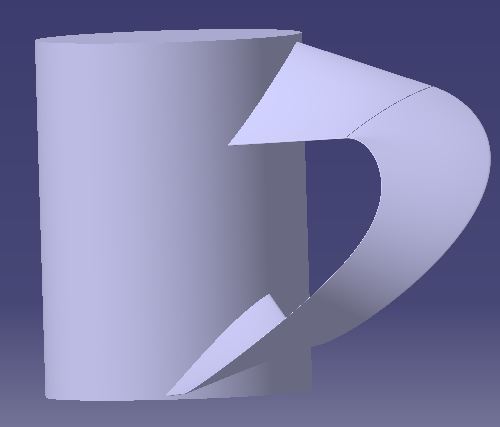
To keep a more classic prop with foil shapes and angles correctly the loop gets quite large and there is little to no thrust created by the loop… I think it needs to be tweaked a lot.
It’s always possible to design one, but you’ll have a terrible drag point on a folding toroidal prop.
Getting there, I could see the inconsistencies with the aerofoil so I filled with superglue and sanded to smooth the profile
and now go! We want to see 500W at 30Km/h
I am looking forward to the results, but already shared my point of view and tipps. Soon we’ll get first trial and error, keep going. And thank you for the work so far.
Lol, I would imagine it will struggle to reach 20kmh because of the low pitch. It will be running a lot faster rpm but hopefully a lot less load. Maybe!
Here is something outside the patent scope: the one-foot Sharrow prop blade.
Who said a Sharrow prop blade needs to be bound on two points to the hub ?
Advantage: the blades fold inside the air bubble behind the propeller hub where there is little water and therefore little drag …
Food for thought : my hitech prototype 
